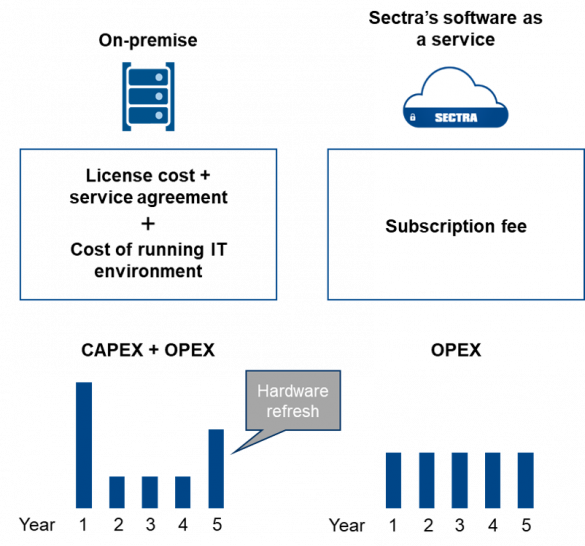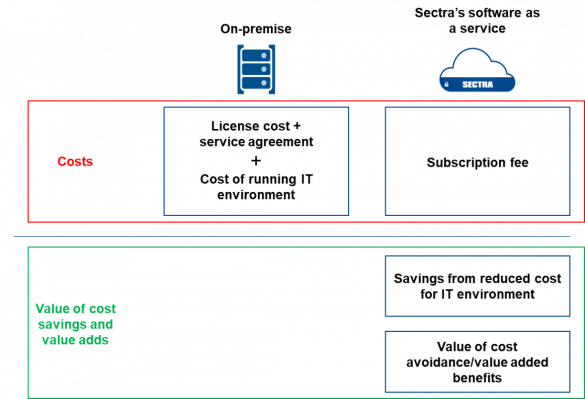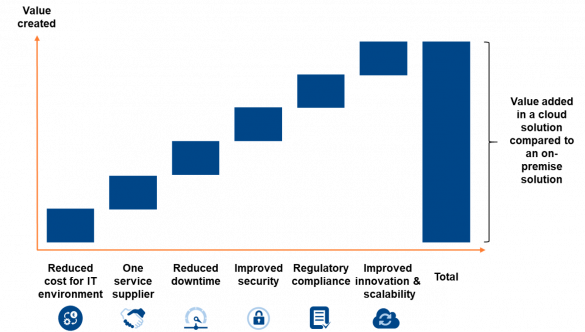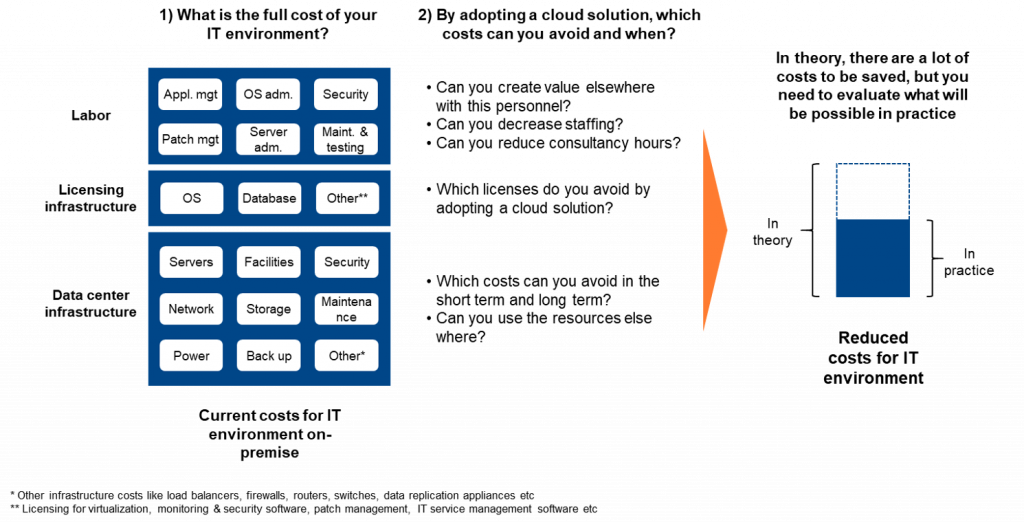Strategic and operational perspective
Before diving into the financials, you should determine whether a cloud-delivered IT system fits your organization’s strategy and operations. The organizational prerequisites are highly dependent on the role, competence and political power of the local IT department and their willingness to store patient data in the cloud (rather than on local servers).
The clinical workflow must also be assessed. An organization with many collaborating sites over large geographical areas is one example where a cloud-based and centralized IT infrastructure would be advantageous over an on-premise environment. Another example is if the workflow is likely to change over time—growth through new sites and modalities, new -ologies, AI research, etc. In this case, the scalability of the cloud outperforms local IT hardware.
Other areas that need to be evaluated are security and fault tolerance. Utilizing SaaS/cloud means that a lot of the responsibility for system uptime and security compliance is outsourced, reducing some of the internal needs.
To evaluate the strategical and operational fit, good questions to ask are:
- Is purchasing SaaS/cloud in line with our strategic direction?
- Is cloud in line with our IT strategy and does it support the future role of our IT department?
- Do managing data centers and hardware represent a core business for our organization?
- What does the internal political landscape look like? Is it sensitive to storing patient data in the cloud? If yes, how can the sense of less control be explained and reduced?
- Given our future operations, is scalability important?
- Are we sufficiently protected against disaster scenarios or could a cloud solution offer improved fault tolerance?
- Do we have the in-house competence and resources to protect ourselves from increased cybersecurity threats?
- Which solution is best for our operations today and tomorrow, both with respect to clinical workflows and costs?
Financial perspective
The main challenge involved in a financial evaluation of the two models is to make a fair comparison between them. A SaaS/cloud delivery model involves the vendor assuming full-service responsibility in terms of hardware, network, real estate and even staff. Therefore, the total cost of the current cost-base needs to be broken down into smaller components to enable a fair assessment of which cost items can be saved, and which will remain.
In addition, you should take into consideration the additional value a cloud-based solution can bring. The additional value should be estimated and include benefits such as higher security and uptime, fast access to new functionality, and reaction time when incidents occur.
Another aspect to consider is the impact on budgeting of the various business models and the time value of money. A reasonable time period for the business case needs to be decided and the present value of the total cost of ownership (TCO) needs to be calculated for the two models. To perform such a calculation, you need to identify the differences.
Understanding the model differences when evaluating the financials
When creating the financial comparison between the models, the TCO must be calculated. This is an area where many organizations struggle because of several difficulties:
- The time value of money needs to be considered in the various business models to calculate the net present value. Decide on the interest rate to use when discounting the costs and added-value items, which is often the weighted average cost of capital (WACC).
- The SaaS/cloud solution will reduce some of your internal costs for hardware, software and maintenance, which can be very difficult to estimate.
- The added benefits of a cloud solution should be estimated and added to the model, which can be challenging.
With respect to business models, a SaaS/cloud delivery is often subscription-based, capitalizing on the organization’s OPEX budget. In contrast, on-premise models use to be offered as a CAPEX-heavy model consisting of a traditional license paid upfront together with a running OPEX-based service fee (see Figure 1).

Figure 1. Illustration of the business model differences between a subscription model and a traditional license + service fee.
An on-premise installation usually means that the hospital must provide the hardware on which the purchased software is installed. Hence, it comes with a rolling cost for the local IT environment and a future hardware refresh that needs to be taken into consideration. The software licenses are usually paid upfront and with them comes a running service agreement fee. What the service agreement includes tends to differ significantly between vendors (see this article, in Swedish). For example, some service agreements include upgrades while other vendors require that you pay to get new functionality.
For an on-premise installation, you should consider the following major cost components:
- License cost + service agreement
- Cost of running IT environment
- Hardware refresh
- Cost of upgrades
With SaaS/cloud offerings, the software is delivered as a service. It is not installed locally, and software upgrades are thus included. You normally pay a running monthly or annual fee for a specific size of utilization, often measured in terms of the number of exams or the number of users. Since the vendor runs the software on its own or a hosting partner’s hardware, you do not need to purchase or maintain the hardware. The SaaS/cloud provider assumes full-service responsibility for both hardware and software, and sometimes also the network. This could mean significantly reduced costs for IT, including both operational costs and long-term investments. These savings need to be identified and taken into consideration together with the estimated added benefits in order to make a fair comparison with an on-premise solution. In total, you need to consider three major components:
- Subscription fee
- Savings from reduced cost for IT environment
- Value of cost avoidance/value-added benefits
The added benefits of the SaaS offering and the estimation of their value is where most comparison models fail, illustrated in green in Figure 2. The following chapter provides a breakdown into smaller components that can be estimated more easily.

Figure 2. Illustration of the costs and added benefits of a SaaS/cloud solution vs. an on-premise solution.
Understand the added benefits of the SaaS/cloud offering
Breaking down the value-added benefits into smaller components allows for an estimation of each component. These components are illustrated in Figure 3 and further described below.

Figure 3. An illustration of the different components of a cloud offering that have potential to reduce costs or add value.
Reduced cost for IT environment
The cost savings that can be achieved for your IT environment is difficult to estimate and requires a further detailed breakdown. Figure 4 can help you understand the total cost base of your current IT environment in order to facilitate an evaluation of how much can be eliminated, in practice by adopting a cloud solution. Note that there are a lot of costs to be saved in theory, but you need to evaluate what will be possible in practice. To evaluate the true costs that can be eliminated or reduced, you should consider factors such as:
- Which costs can be eliminated and when?
- Can our current resources be used elsewhere?
- Reduced costs for energy, hardware and data center staffing?

Figure 4. An illustration of the different cost components of the IT environment where there is potential to save costs.
One service supplier
In addition, you need to evaluate the savings that can be made by only dealing with one supplier. This might involve a higher risk in terms of having one point of failure, but in general one contracting party provides significantly more benefits than a conglomerate of vendors in terms of less coordination and administration and the utilization of effective service level agreements (SLAs).
Evaluate factors such as:
- How much can you save by spending less time on coordination and administration of vendors?
- How much time do you spend each year on finding the root cause of IT problems?
- How much time will you save by avoiding “dead end” situations where vendors blame each other?
- By using one full-service provider instead of several vendors, it will it be easier to handle and make effective use of SLAs. Would our organization benefit from using SLA-connected fines if the supplier fails to deliver an uptime as promised?
Reduced downtime
These days, downtime has become a dirty word in healthcare. Luckily, the cloud goes a long way in reducing downtime and keeping health providers up and running. In the event of a disaster, hosting data offsite in a cloud environment provides better safety. Additionally, with an ultra-low latency network, together with geographically separated mirrored instances, your data can usually be recovered quickly and efficiently.
With high availability solutions that offer advanced security and reliability, health providers can spend less on backups and redundancy. To estimate the value of uptime, read this article or use the following questions to create your own estimate:
- What is the number of downtime hours today across all users and what is it worth? Compare this with a calculation based on the uptime track record of the cloud solution you are currently evaluating.
- What is the value of less downtime and data loss in case of a disaster scenario?
Improved security
Most cloud providers offer higher security, risk management and monitoring services to protect their users from unauthorized access and breaches. Another key benefit is the cloud provider’s capability to act fast once a new bug or threat occurs, which can be difficult in large and complex healthcare organizations with hundreds of IT systems. One real example of how the increased speed of a SaaS/cloud solution provided value during the Wannacry outbreak in 2017 is described in this article.





